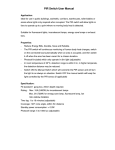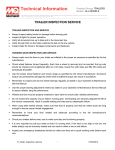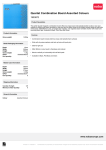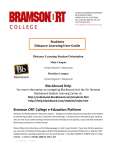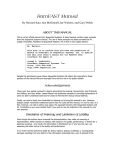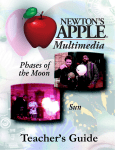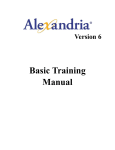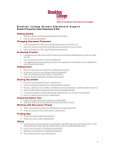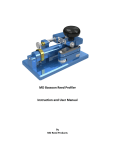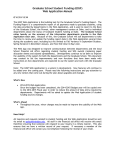Download User`s Manual - College of Arts and Architecture
Transcript
The Stuckeman Family Building User’s Manual Dear SALA Student: Welcome to the Stuckeman Family Building (SFB), the home of the School of Architecture and Landscape Architecture! From its inception the SFB was conceived as a “green building.” Specifically, this means that the SFB was designed to meet the U.S. Green Buildings Council criteria for a LEED Gold-rated building. More generally, the building and its surrounding site features utilize a high percentage of recycled materials and products made through sustainable production methods. The SFB uses energy efficiently, and was designed to minimize the negative effects of its development on the environment. Our vision of sustainability for the SFB and its grounds is one that depends on the active participation of all members of the SALA community. Human beings can only sustain those things they care about. It is for this reason we ask that you read and follow the contents of this User’s Manual. Unlike some other university buildings, in the SFB a greater proportion of the materials are more typical of a commercial or residential building. For example, the stairwells in the SFB are sheathed in painted gypsum board or drywall. The elevator lobbies are sheathed in maple veneer paneling. Some of the paving is flagstone, and the studio floors are raised concrete panels. Please consider the quality and durability of this building and its site as you use them. There should be no population of users more likely to respect buildings and landscapes, and to help sustain them, than those in SALA—and the durability of buildings is a key element of sustainability. Some things you’ll need to know as an SFB User: Security The first floor entrances to the building will remain unlocked whenever the Library is open. After 7:00pm and on weekends and university holidays you will need to your PSU ID to use the elevators or access the stairwells. This is intended to keep unauthorized persons out of the studio levels of the building. When the building is closed – generally from 11:00pm to 7:00am – you will need your ID to gain access to the building. You must not prop open exit doors—to do so compromises the safety and security of every building user. There are security cameras trained on all of the exits from the building and they are motion-activated, wired back to Univ. Police. They can be viewed real-time or on tape afterwards by the police in the event of theft or other incidents. Many of the light fixtures in the building are controlled by motion sensors coupled with timers. If you occupy one area of the building for a longtime, but barely move, it is possible the lights will go out. By simply moving around a bit, you should be able to get the lights to come back on. In the studios, the light fixtures near the Mezzanine will remain lit, even when the motion sensors and occupancy detectors turn all other lights out, for emergency exit safety. Building Care Gypsum walls are easily gouged and damaged. Please take care when using the stairwells especially when transporting bulky items that might come in contact with these walls. Do not post signs in the stairwells, as the tape or pins will quickly destroy the painted surface of the walls. There are tackable surfaces at every level of the building that should be used for posting notices. Please properly dispose of all food and drink containers in the appropriate trash and recycling bins. In particular, the first floor of the SFB is a very public area. We would like the visitors to our building to leave with the impression that this facility is properly cared for and valued by its occupants. Never, NEVER use spray paint, spray glue or fixative anywhere in the building or on the surrounding paved areas – use one of the two spray booths. Overspray or graffiti in and around spray booths are unsightly and result in repairs which are costly. Since many of the critique and jury spaces are shared between the two departments, it is important for students to remove all drawings and models from these spaces after a review is over. Work left behind will need to be moved by the group using the space after you. Not only does this force the next users to waste time clearing and cleaning the space, it also increases the risk that your work will be lost or damaged. No one else is likely to be careful with your drawings and models. We intend to institute a studio clean up day and time that is uniform for the entire building. We will provide you with more information on this as soon as we discuss this schedule with the OPP Janitorial supervisors. Landscape Care Please don’t litter around the building. Smokers should use trash receptacles to dispose of cigarette butts. The sloped grass area adjacent to the Building Yard is intended to serve, in mild weather, as a place for students to sit and watch the activities in the yard. The slope of this lawn is rather steep, so please stay off the grass in wet weather. Too much activity on this grass area when it is wet will cause erosion. It is also likely to be quite slippery when wet. You will notice that many of the plants around the building and parking lot are unusual for Penn State. Some of these plants were selected because they will eventually require no watering and little maintenance. Please stay out of the planting beds. Give the plants a chance to survive and to perform as they were intended. Furniture Dos and Don’ts Use great care when changing the angle of the drafting surface of your desk. Keep fingers, clothes, and objects away from the joint between the tilting top and the table surface. If, in consultation with your studio instructor, you need to move desks, be careful and lift them by the entire desktop, not just the drafting portion. Students in the tiered studio areas need to take care that they do not push their desks or storage units over the edge of a level of the studio. A student sitting on a lower level could be seriously injured by a storage unit that falls on them. Studio furnishings (drawing tables, chairs, lockers) are available to each student and often students “claim” these items on a semester or yearly basis relevant to their studio. Do not use permanent markings to lay claim to these items, as they will be used by other students in future semesters and years, but instead mark these items using tape that can be removed after that semester or studio is complete. Keys to storage units will be distributed by your respective department office. If you lose a key of fail to return one at the end of semester, your bursar’s account will be charged for the cost of replacing the lock. Posting Signs, Messages, Fliers Please do not tape fliers and announcements to the doors or walls of the building. This will mar the finish of the wood, or damage the paint. Use the tackable surfaces near the elevators, or other bulletin boards to post fliers and notices. Do not pin things into the drywall or wood walls. In-Floor Ventilation System The studio floors function as a pressurized plenum to distribute ventilation air. This air will be warmed in cold weather, and cooled when the building is being air-conditioned. The circular registers in the floor control the flow of air. If one of these is near your desk, it is intended that you can adjust it to suit your preference for more or less air. By turning the register grille, you can adjust how much air flows through it. Keep in mind that others sitting nearby you are likely to be depending on the same floor register for their thermal comfort, so please take their needs into account too. In some cases (for instance if one is directly under a single desk) it may make sense to request that the register be relocated. Talk to your studio professor if you think one of the vents should be moved. Under Floor Access Students are not authorized to remove the studio floor panels or to make changes to the floor panel layout, vent locations, power, or IT wiring. Only SALA staff and OPP personnel are permitted to remove or relocate floor panels. If you are having a problem with your wired IT connections, with electrical power, or if you notice a floor panel is loose, please bring it to the attention of your studio instructor or the staff in the main department offices. We’ve tried to keep this list of recommendations and rules as brief as possible. Thank you for taking time to read it. Rather than present you with a long laundry list of regulations, we were hoping that a rather short, representative list would give everyone the idea what it will take to properly care for this facility. Our goal is to foster a general attitude of stewardship among the residents and users of the SFB. The job of sustaining the SFB and its exterior spaces is one we all share. We’d be happy to hear the ideas of individual students or our student groups regarding the ways we can best utilize our new home. As with any new place, it takes a while to figure out how to inhabit it wisely. All brilliant suggestions are welcome! Sincerely, SALA Council: Kelleann Foster, Landscape Architecture Department Head Scott Wing, Architecture Department Head Jawaid Haider, Professor of Architecture Barry Kew, Assistant Professor of Landscape Architecture Darla Lindberg, Associate Professor of Architecture Eliza Pennypacker, Professor of Landscape Architecture Brian Orland, Director, Stuckeman School of Architecture and Landscape Architecture 9/23/2009 2


